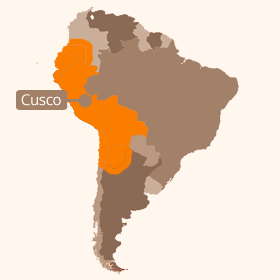
The History of the Inca Empire
When the Spanish conquistadors made landfall in the New World, the Inca Empire had come to dominate much of South America, from the south of modern Colombia, right down into what today are Chile and Argentina. From their capital city of Cusco, high in the Andes mountains, they expanded in all directions, often brutally attacking neighbouring populations and bringing them under Inca domination. By 1535 they had brought huge swathes of the continent under their control, but their repressive rule bred huge discontent among the conquered populations and would lead indirectly to their downfall at the hands of the Spanish...
In their Andean heartlands, Inca cities, temples and forts were mainly built on high ground, leaving the fertile valley floors free for agriculture. Their public and high-status buildings were built of stone, using a mortarless construction which was so accurate that you can’t even fit a knife-blade between the huge blocks, which can weigh as much as several tons. All this was achieved without using the wheel, and is testament to the huge amount of labour which the Incas could mobilise. Towns and villages were linked by a paved road system which extended throughout the Empire, and a network of runners known as chasqui were able to transmit news and information very quickly over long distances. The road was also guarded by a system of fortresses both large and small, with one of the largest, Sacsayhuaman guarding Cusco itself.
![Sacsayhuaman]()
Society and Culture
Llamas were used as pack animals, but were also kept for meat along with animals such as alpaca and guinea pigs. The Incas were excellent agriculturalists, and used systems of terraces to gradually cross-breed and “acclimatise” plants so they could be grown at higher altitudes, thus increasing the amount of land which could be used for cultivation. Potatoes, peanuts and tomatoes were all improved in this way, along with the sacred coca plant which was at the centre of Inca ritual life. At the centre of every Inca village and town was an altar dedicated to Inti, the Andean Sun God, and where coca leaves and other offerings were left. Priests possessed sophisticated astronomical knowledge and festivals were tied to dates like the winter and summer solstices. The winter solstice, Inti Raymi, is still widely celebrated throughout the Andes today.
The whole of the Inca Empire was strictly hierarchical. At the top of the pyramid was the Inca himself, and beneath him were the Sapa (High Priest) and a separate military commander. Noble families provided councillors to the Inca, as well as family members becoming priests and military leaders. Non-nobles could become skilled artisans such as stone-masons or rise through the military ranks, but most were simply farmers or labourers, who paid tax in the form of labour and goods. Although the Incas did not seem to have a full written language, these taxes were recorded in the form of the unique quipu system of knotted threads.
![The ransom room in Cajamarca]()
Arrival of the Spanish
When the Spanish arrived on the coast of Peru, the Incas had an army which is estimated at around 40,000 strong, whereas the Spanish numbered only 180 soldiers. However, leader of the conquistadors, Francisco Pizarro, realised that the Inca Empire was in the grip of a civil war caused by the death of the Inca Huayna Capac. In this context, the Spanish ranks were swelled by large numbers of warriors from other indigenous groups who saw their chance to throw off the Inca yoke. This, together with the diseases the Spanish had introduced into the New World, and the impact of steel and firearms on a Stone Age battlefield, meant that the whole edifice of the Inca Empire came crumbling down in an astonishingly rapid timeframe. The Empire had been divided between two of Huayna Capac's sons: Huascar was given the southern provinces and the capital city of Cusco, while Atahualpa was given control over modern Ecuador, Colombia, and parts of northern Peru. Eventually, they clashed in battle and Atahualpa routed Huascar's army, seizing control over the whole (but now fatally weakened) Empire.
Atahualpa initially saw the Spanish as mere raiders and agreed to meet them in the city of Cajamarca, and to offer them a ransom to leave his territories. However, the conquistadors under Pizarro took the ransom but captured and eventually executed Atahualpa, installing a puppet ruler in Cusco and founding a new capital in Lima. After just six years, however, internal feuds resulted in the assassination of Pizarro and the imposition by Spain of a new Governor of Peru (Christobal Vaca de Castro) and effectively marked the end of the Inca Empire.